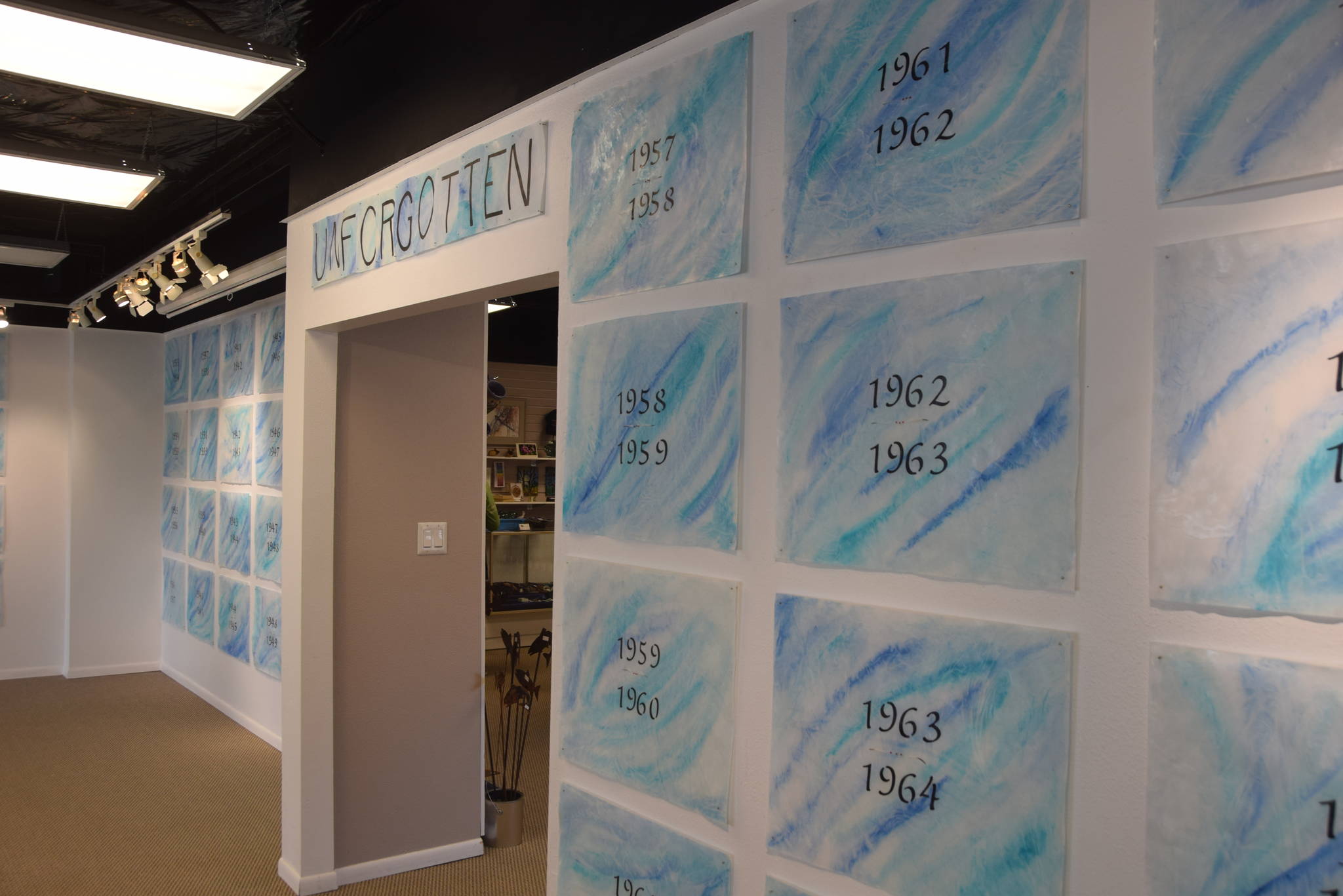This month’s installation at the Kenai Fine Art Center will attempt to evoke the history and legacy of Alaska’s education system on its Native cultures. Joel Isaak, a local artist and a member of the Kenaitze Indian Tribe, has created a piece entitled “Unforgotten” that will be on display for the month of August. Tonight there will be an opening reception for Isaak’s installation featuring a traditional potlatch ceremony and a performance from local musician George Holly.
For this installation, Isaak took a break from his usual medium of bronze statuary casting. “Unforgotten” is a series of 134 watercolor paintings dipped in wax and colored with light blue hues that have a translucent, marble texture. Each piece features two years written in ink and separated by porcupine quills and glass beads, and the dates run from 1885 to 2019.
1885 is the year that Presbyterian minister Sheldon Jackson was appointed as General Agent of Education in Alaska, and Isaak said that this was when the history of Alaska’s Native education practices began. In a report to Congress in 1886, Jackson said of Alaska’s indigenous population: “The children grow up amid filth and uncleanliness, accustomed to impure sights and conversation, and systematically taught to lie and steal,” and that teachers “must try to educate them out of and away from the training of their home life.”
Isaak said that Jackson set up the era where boarding schools in the state began a forced assimilation of Alaska Native children that attempted to replace the culture of their family with an American one. Isaak said that this assimilation often included abusive practices and required a complete separation from the children and their Native culture.
“You were beaten for speaking your language, girls were forced to wear skirts and kneel on rock salt … There are elders in this area who went to school around here and were beaten so badly that they couldn’t walk for three days,” Isaak said. These practices continued well into the 20th century, and the last boarding schools were in operation in Alaska up until the mid 1970s.
Isaak’s goal in creating this installation was to memorialize all the loss that has occurred as a result of these practices — whether it’s a loss of language, culture or life. But rather than just dwelling on the darkness of the past, Isaak hopes to bring a healing element to the conversation as well. Isaak said he used light colors on pieces of paper rather than slabs of granite or marble to symbolize the ephemeral nature of the situation: nothing is meant to last forever, and much improvement has been made since the boarding school days.
“Rather than a literal representation where I say ‘here are a bunch of gravestones’ I wanted to interpret the experience to create a space that gets people to ask questions and start conversations,” Isaak said.
Although the boarding school assimilation practices are no longer in effect, the dates on the paintings go all the way to the current year. Isaak said that even today, what little is taught about Sheldon Jackson in schools paints a whitewashed image of his legacy.
“The Native people have a little bit of a different story to tell than the history books,” Isaak said.
These days, there are attempts to bring back the Native cultures that were actively suppressed for decades. Kids are no longer beaten in school for speaking Dena’ina or Yupik, and Isaak and others now offer classes in Native languages at Kenai Peninsula College and other college campuses across the state. With all that in mind, one of the questions that Isaak hopes the installation will prompt from people is “When is the work ever really done?”
The Kenai Fine Art Center will hold an opening reception for Isaak’s “Unforgotten” installation tonight from 5 to 7 p.m. The reception is free and open to the public, and the Fine Art Center is located across from the Oiler’s Bingo Hall in Old Town Kenai. Call 907-283-7040 for more information.

